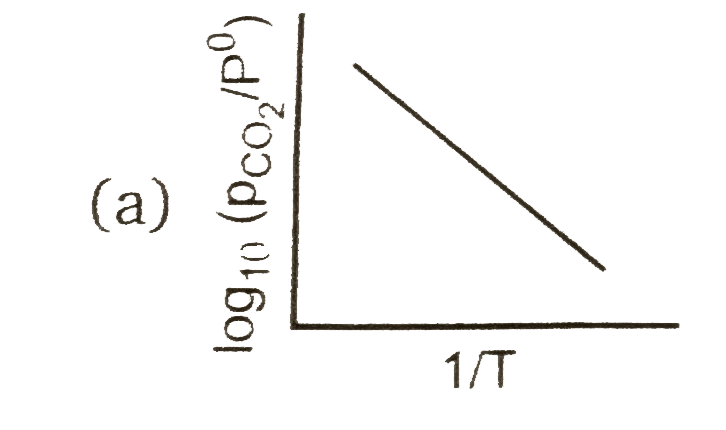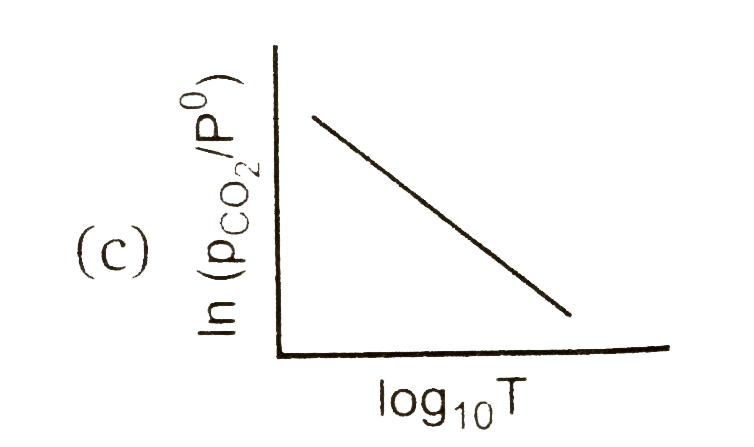For the chemical equilibrium,
CaCO3(s)⇔CaO(s)+CO2(g)
ΔrHɵ can be determined from which one of the following plots?




The correct Answer is:a
To determine the enthalpy change (ΔrH°) for the equilibrium reaction:
CaCO3(s)⇌CaO(s)+CO2(g)
we can analyze the relationship between the equilibrium constant (Kp) and temperature (T). The equilibrium constant Kp can be expressed in terms of the partial pressure of CO2, since the solid components (CaCO3 and CaO) do not contribute to the equilibrium expression.
1. Write the Reaction and Identify Kp:
The reaction is:
CaCO3(s)⇌CaO(s)+CO2(g)
The equilibrium constant Kp for this reaction is given by:
Kp=PCO2
where PCO2 is the partial pressure of CO2.
2. Use the Arrhenius Equation:
According to the Arrhenius equation, the relationship between Kp and temperature is:
Kp=Ae−ΔH∘/RT
Taking the logarithm of both sides gives:
lnKp=lnA−ΔH∘R⋅1T
3. Rearranging the Equation:
We can rearrange this equation to:
lnKp=lnA−ΔH∘R⋅1T
This can be compared to the linear equation y=mx+c, where:
- y=lnKp
- m=−ΔH∘R
- x=1T
- c=lnA
4. Determine the Slope:
From the rearranged equation, we see that the slope (m) is negative, indicating that as 1T increases, lnKp decreases.
5. Identify the Correct Plot:
To find ΔrH°, we need to plot lnKp against 1T. The correct plot will show a linear relationship with a negative slope.
6. Conclusion:
The plot that correctly represents this relationship will have lnKp on the y-axis and 1T on the x-axis, with a negative slope.
Final Answer:
The correct plot to determine ΔrH° for the reaction is option A (the plot showing lnKp vs. 1T with a negative slope).
The reaction is:
CaCO3(s)⇌CaO(s)+CO2(g)
The equilibrium constant Kp for this reaction is given by:
Kp=PCO2
where PCO2 is the partial pressure of CO2.
According to the Arrhenius equation, the relationship between Kp and temperature is:
Kp=Ae−ΔH∘/RT
Taking the logarithm of both sides gives:
lnKp=lnA−ΔH∘R⋅1T
We can rearrange this equation to:
lnKp=lnA−ΔH∘R⋅1T
This can be compared to the linear equation y=mx+c, where:
- y=lnKp
- m=−ΔH∘R
- x=1T
- c=lnA
From the rearranged equation, we see that the slope (m) is negative, indicating that as 1T increases, lnKp decreases.
To find ΔrH°, we need to plot lnKp against 1T. The correct plot will show a linear relationship with a negative slope.
The plot that correctly represents this relationship will have lnKp on the y-axis and 1T on the x-axis, with a negative slope.
The correct plot to determine ΔrH° for the reaction is option A (the plot showing lnKp vs. 1T with a negative slope).
Similar Questions
For the reaction CaCO3(s)⇔CaO(s)+CO2(g)kp is equal to
View SolutionFor CaCO3(s)⇔CaO(s)+CO2(g),Kc is equal to …………..
View SolutionThe equilibrium,BaCO3(s)⇔Ba0(s)+CO2(g) will shift in left hand direction by
View SolutionFor the reaction CaCO3(s)⇔CaO(s)+CO2(g) the equilibrium amount of CO2 can be increased by :
View SolutionKp = 1, For the equilibrium CaCO3(s)⇔CaO(s)+CO2(g). The temperature of the reaction can be given as :
View SolutionThe reaction CaCO3(s)⇔CaO(s)+CO2(g) reaches the state of equilibrium when
View SolutionCalculate the pressure of CO2 gas at 700K in the heterogenous equilibrium reaction CaCO3(s)⇔CaO(s)+CO2(g), if ΔGɵ for this reaction is 130.2kJmol−1.
View SolutionFor CaCO3(S)⇔CaO(s)+CO2(g),ΔH = + Q at equilibrium. The addition of more CaCO3(s) causes?
View SolutionFor the reaction CaCO3(s)⇔CaO(s)+CO2(g), the pressure of CO2 depends on
View SolutionFor the reaction, CaCO3(s)→CaO(s)+CO2(g), which is the correct representation?
View Solution
